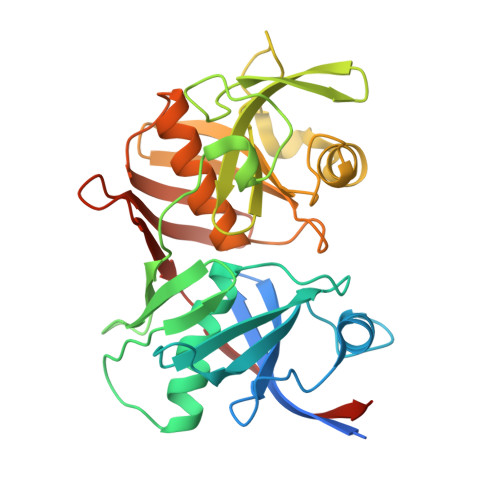Crystal structure of diaminopimelate epimerase from Arabidopsis thaliana, an amino acid racemase critical for L-lysine biosynthesis.
Pillai, B., Moorthie, V.A., van Belkum, M.J., Marcus, S.L., Cherney, M.M., Diaper, C.M., Vederas, J.C., James, M.N.(2009) J Mol Biology 385: 580-594
- PubMed: 19013471
- DOI: https://doi.org/10.1016/j.jmb.2008.10.072
- Primary Citation of Related Structures:
3EJX, 3EKM - PubMed Abstract:
Diaminopimelate (DAP) epimerase is a key enzyme for the biosynthesis of lysine in plants. Lysine is an essential dietary nutrient for mammals. In both plants and bacteria, DAP epimerase catalyzes the interconversion of LL-DAP and DL(meso)-DAP. The absence of a mammalian homolog makes DAP epimerase a promising target for the design of novel herbicides and antibacterials. This enzyme requires no cofactors and it functions through an unusual mechanism involving two cysteine residues acting in concert and alternating as a base (thiolate) and as an acid (thiol). The present study reports the crystal structures of two enzyme-inhibitor complexes of DAP epimerase from Arabidopsis thaliana with different isomers of the irreversible inhibitor and substrate mimic, 2-(4-amino-4-carboxybutyl)-aziridine-2-carboxylate, at 1.95 and 2.3 A resolution. These structures provide the first atomic details of a plant amino acid racemase. Structural analysis reveals that ligand binding to a cleft between the two domains of the enzyme is accompanied by domain closure with two strictly conserved cysteine residues, Cys99 and Cys254, optimally positioned to perform acid/base catalysis via a carbanion stabilization mechanism on the stereogenic alpha-carbon atom of the amino acid. Stereochemical control in catalysis is achieved by means of a highly symmetric catalytic site that can accommodate both the L and D stereogenic centers of DAP at the proximal site, whereas specific interactions at the distal site require only the L configuration. Structural comparisons of the plant enzyme with its bacterial counterpart from Haemophilus influenzae reveal significant conservation of amino acid residues around the active site that extends to their three-dimensional structures and catalytic mechanism.
- Group in Protein Structure and Function, Department of Biochemistry, University of Alberta, Edmonton, Alberta, Canada T6G 2H7.
Organizational Affiliation:

















